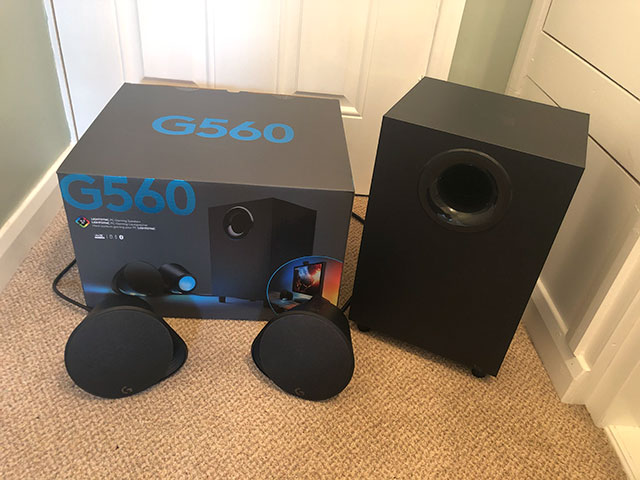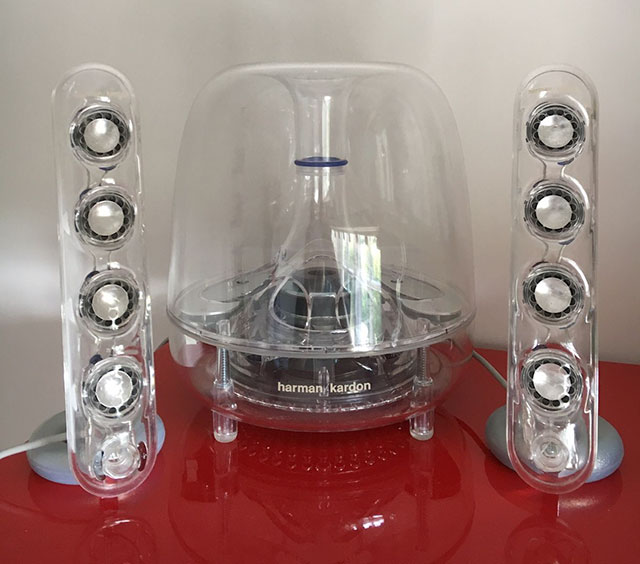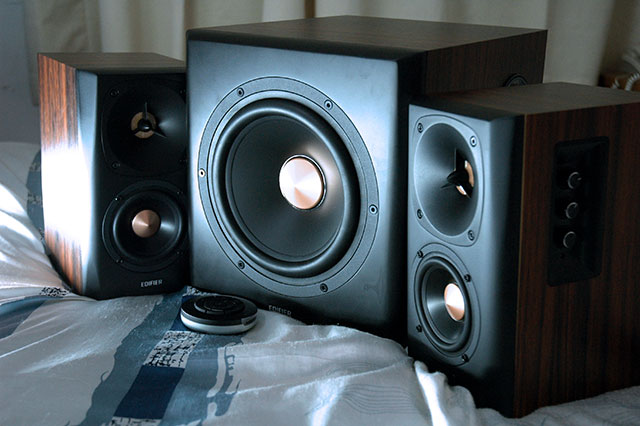![best computer speakers 2020]()
There is nothing quite like sitting at your desk and enjoying the kind of sound that envelopes the entire room. If you’re looking to transform your desktop audio experience, we found 11 excellent speakers that are up to the task of filling your ears with luxurious sound.
![best computer speakers 2020: Audioengine A2+ Wireless]()
The Audioengine A2+ is no longer the new kid on the block. Still, it remains a great value buy for the very same reason today that it became popular when it first arrived nearly five years ago. Slick-looking with a built-in DAC and support for your PC’s USB port, as well as an RCA output to make it easier to connect the A2+ to an external woofer — which Audioengine also sells, by the way — the A2+ is easy to praise and hard to find fault in.
Pros:
• No audio compression through the USB input
• Comes with a built-in converter for digital to audio
Cons:
• No subwoofer
(Check here for the price)
![best computer speakers 2020: Logitech Z623]()
Logitech’s best computer speakers are relatively expensive compared to Logitech’s other offerings, but at the same time, the Z623 is a lot more affordable when you consider how expensive products in similar specs are. This is especially true when you consider the audio quality of the Z623 and how easily you can adjust its sound, including its subwoofer. The impressive highs and mids create an immersive audio experience that belies the Z623’s reasonable pricing.
Pros:
• Great highs and mids
• Subwoofer packs a lot of power
• Reasonably priced
Cons:
• Bass might be too heavy for some people
(Check here for the price)
![best computer speakers 2020: Logitech G560]()
The Logitech Z623 might just be Logitech’s best computer speakers, but that doesn’t mean that it’s the only one worth investing in. Another one of their strong contenders is the Logitech G560, which is Logitech’s first set of gaming speakers ever produced, and although this is their “first” gaming-centric product, it’s safe to say that they pulled it off rather quite well.
Featuring RGB lighting and adjustable multi-colored illumination via Logitech’s own software, as well as decent audio clarity and quality, the Logitech G560 might not blow you away, but it will create a mesmerizing experience.
Pros:
• RGB lighting
• Adjustable multi-colored illumination
• Support for DTS surround sound technology
Cons:
• Premium price for not a whole lot of top-tier performance
(Check here for the price)
![best computer speakers 2020: Harmon Kardon SoundSticks Wireless]()
The wireless version of the Harmon Kardon SoundSticks doesn’t come cheap, but it’s no slouch either. The fact that it has Bluetooth connectivity gives it an inherent advantage over other competitors. However, it’s not what justifies its high asking price — the unique design and satisfying wireless performance is what does it for this pair of speakers.
It also helps that the SoundSticks features excellent audio quality with minimal distortion, even when placed a few feet away.
While it’s definitely not cheap, audio enthusiasts with deeper pockets will appreciate the convenience of having these amazing looking wireless speakers that they can connect to pretty much anywhere in their living room.
Pros:
• One-of-a-kind design
• Seamless Bluetooth connectivity and support
• Always-on Bluetooth
Cons:
• Always-on Bluetooth
(Check here for the price)
![best computer speakers 2020: Klipsch ProMedia]()
A common issue among computer speakers is that they’re seemingly built exclusively for gaming. This means that you can’t really use them and expect excellent performance when watching movies and/or listening to music. But that’s not the case for these THX-certified speakers.
With a wide frequency range starting as low as 31Hz and as high as 20kHz, the Klipsch ProMedia pairs powerful bass with detailed audio quality, creating a balanced mix of lows, mids, and highs. This results in an audio experience similar to that of a home theater, except without the high asking price.
Pros:
• Audio performance similar to home theaters
• THX-certified
• Reasonably priced
Cons:
• US-only
(Check here for the price)
![best computer speakers 2020: Edifier S350DB]()
They say that big things come in big packages. Or, wait, maybe we go that wrong? Either way, the Edifier S350DB definitely isn’t the most svelte of computer speakers, but it is one of the best — there’s no denying that.
A true 2.1 audio system, the S350DB comes with titanium dome tweeters and an 8-inch subwoofer. This allows it to deliver thundering bass and clear high-frequency music all the same. Not to mention, it has Bluetooth 4.1 connectivity, as well as a well-designed wireless remote control for convenient access. Finally, completing the S350DB is a 2-year warranty that gives you the peace of mind that you won’t get with other computer speakers.
Pros:
• Comes with titanium dome tweeters and an 8-inch subwoofer
• Bluetooth 4.1
• 2-year warranty
• Beautifully crafted with solid construction quality
Cons:
• Lacks bass/treble controls via remote
(Check here for the price)
![best computer speakers 2020: Presonus Eris E4.5]()
Sporting a clean and basic design, the Presonus Eris E4.5 doesn’t look like that much of a performer. But play it on full sound and you’ll find that it is easily one of the best computer speakers in and above its price range. This is high praise when you consider how tight the competition is at its price point.
What really sets the Eris E4.5 apart is that it is a 2-way speaker with a Class A/B amplifier on top of 4.5-inch drivers. Equipped with a 1-inch silk dome tweeter, as two transducers, and an interesting set of features, which includes unbalanced RCA inputs, TRS, and acoustic tuning controls from the lows, mids, and highs, it’s not hard to justify why the Eris E4.5 is part of our round-up.
Pros:
• Robust feature set
• Impressive build quality
• Basic but effective design
• Well-rounded audio performance
Cons:
• Doesn’t really stand out in both looks and performance
(Check here for the price)
![best computer speakers 2020: Fluance Ai40W]()
Whereas some speakers focus on being loud, both literally and in terms of design, the Fluance Ai40W is content with a low-key design with a performance that caters more to the low-latency and high-fidelity audio-loving audience.
So long as that’s the kind of audio performance that you’re looking for, the Fluance Ai40W is worth the investment. Otherwise, you can enjoy a louder performance without spending as much.
Pros:
• Bluetooth apX compatibility
• Multiple connectivity options
• Convenient set-up
• Backed by a 2-year warranty
Cons:
• Bass is too dependent on volume level
• Noticeable delay in remote command
(Check here for the price)
![best computer speakers 2020: Edifier R1700BT]()
Sharp looks, compact design, Bluetooth 4.0 streaming, and excellent audio performance, all at a competitive price point, what more can you ask for?
Really, what more can the Edifier R1700BT do given its asking price?
Bass performance might not be the best, but it’s passable. Not to mention, the lovely and engaging highs and midrange more than make up for its slightly spotty bass. Plus, we’re talking about Edifier here, one of the best in the business, so rest assured that your money is in safe hands with the R1700BT.
Pros:
• Aggressive pricing
• Warm and lovely sound
• Easy on the ears
• Classy looks and overall finish
Cons:
• Controls could use a bit of an investment
• Bass too boomy
(Check here for the price)
![best computer speakers 2020: Klipsch R-15PM]()
If money is no issue, we’d gladly recommend the Klipsch R-15PM. In fact, scratch that. If you can buy this, even if you have to stretch your budget by A LOT, then we recommend it. This is because the R-15PM is the best computer speakers around — bar none.
Built seemingly only for high-end users, the R-15PM ticks off all of the right boxes and none of the wrong ones. This includes having as many as five different input options, a small remote that lets you tune in to multiple audio sources simultaneously with on-the-fly switching, and a built-in amplifier that makes external DACs moot and unnecessary.
If you can afford to add the Klipsch R-10SW to your set-up, you’ll be set for life with the R-15PM. Spending any more would yield little to no improvements if any at all.
Pros:
• The best computer speakers on the market
• Built-in amplifier
• Exhaustive connectivity options
• Packs pretty much everything that an enthusiast could ever ask for in a computer speaker
Cons:
• PRICEY
(Check here for the price)
![best computer speakers 2020: Micca PB42X]()
You know how a lot of audiophiles tend to get snobby because they have some of the most impressive and expensive gears around? Well, you can have that too, but without having too spend as much.
The Micca PB42X might not be the best computer speakers ever, but they’re the best in its price range. It’s essentially the well-loved MB42X but equipped with a Texas Instruments Class D amp chip that’s capable of putting out as much as 50 watts per channel so long as it receives enough supply. That alone is what drives the value of the PB42X so high.
If you want to enjoy audiophile-class audio without the audiophile-class price, the Micca PB42X will let you do just that.
Pros:
• Excellent performance at a bargain price
• Built-in Class-D amplifier
• High-performing silk dome tweeters and balanced woven carbon fiber woofer
Cons:
• Zero upgrade flexibility
(Check here for the price)
Things to Consider When Choosing a Computer Speaker
Passive vs Powered Speakers
The best and most simple way to answer this is that powered speakers come with their built-in amplifiers. This means that you can connect them to a mixing board directly. On the other hand, you’ll need to plug in passive speakers to external amplifiers first before connecting them to a mixing board.
Bluetooth vs Wired Speakers
Just as the name suggests, wired speakers use either a 3.5mm jack or a USB cable to connect to the audio source. Meanwhile, Bluetooth speakers don’t need to be connected to the audio source. They can be connected wirelessly via Bluetooth technology to supporting audio devices. Some speakers also use other types of wireless technology such as the 2.4Ghz or 5.0Ghz wireless band.
Sound Clarity
The audio clarity of speakers usually depends on the mids and highs. The mids, especially, range between 250Hz and 2000Hz audio frequency and are mainly responsible for the voices and vocal output of the speakers. Too much emphasis on the mids though can lead to the headphone sounding hollow as if the sound was coming from out of the telephone.
As for the highs, or the treble, these represent the highest frequency range and usually starts at 2,048Hz and end at around 20,000Hz. They’re what helps give speakers detail and clarity, kind of like how microphones let you see things that you normally wouldn’t be able to use your naked eye.
Using speakers with a good mix of mids and highs is imperative for proper audio clarity. The highs, for example, will allow you to enjoy good quality music better. However, keep in mind that good treble resolution will make flawed music sound even worse, although you may want to avoid treble-heavy speakers because of how the emphasis on the high tones might make sound shrill and annoying.
How Is the Bass Input?
The bass input (ranging from 0Hz to 256Hz) are the notes responsible for making rooms and other stuff inside the room shake. They’re usually what makes listening to music fun. But not all speakers come with subwoofers. It’s important to keep that in mind. It’s also just as important to watch out for speakers that make up for their lack of audio clarity and detail by overcompensating with too much bass.
How Many Inputs Does It Have?
Many speakers can only be connected to a single source because it offers only a single input connection. If you plan on using your speaker to listen to various audio sources, you’ll want to look for a speaker with multiple inputs. This is on top of the Bluetooth or Wireless connection.
Does It Have a Headphone Jack?
This used to be a pre-requisite in the past, but these days, this is more of a bonus. Still, if you’re using enthusiast-grade headphones and want to plug it into your speakers, a system with a headphone jack is ideal.
Does It Have Dedicated Controls?
Manual control over the lows, mids, and highs is important. Bass, in particular, can be quite disruptive, especially if you have neighbors. Manual and dedicate controls can let you adjust the audio without compromising the quality or loudness of your music.
What is Sensitivity?
The sensitivity refers to how loud your speaker can go depending on how much power it’s using. The higher the sensitivity rating of your speakers, the louder it can get using a certain input of amplified power.
What Does Frequency Response Mean?
The normal hearing frequency range of the human being is 20Hz to 20,000Hz. Therefore, the frequency response of the speakers affects the quality of the music that we perceive. And while the average human being’s hearing frequency range can’t go much lower or higher than what’ve already stated, a speaker with a frequency response higher or lower than our hearing range can have a lot of benefits.
For example, speakers that can go up to 25,000Hz can let you perceive the subtle improvement in sound quality, such as the snappy sounds of a snare drum, among others.
What Is Power Handling?
Root Mean Square (RMS) power handling refers to how much power the speaker can handle on a continuous basis. Meanwhile, the peak power handling is the maximum power level value that the speaker can handle in short bursts.
Ideally, you’ll want a high RMS and Peak power handling rating.
The post The Best Computer Speakers Of 2020 appeared first on Caveman Circus.



















































































































